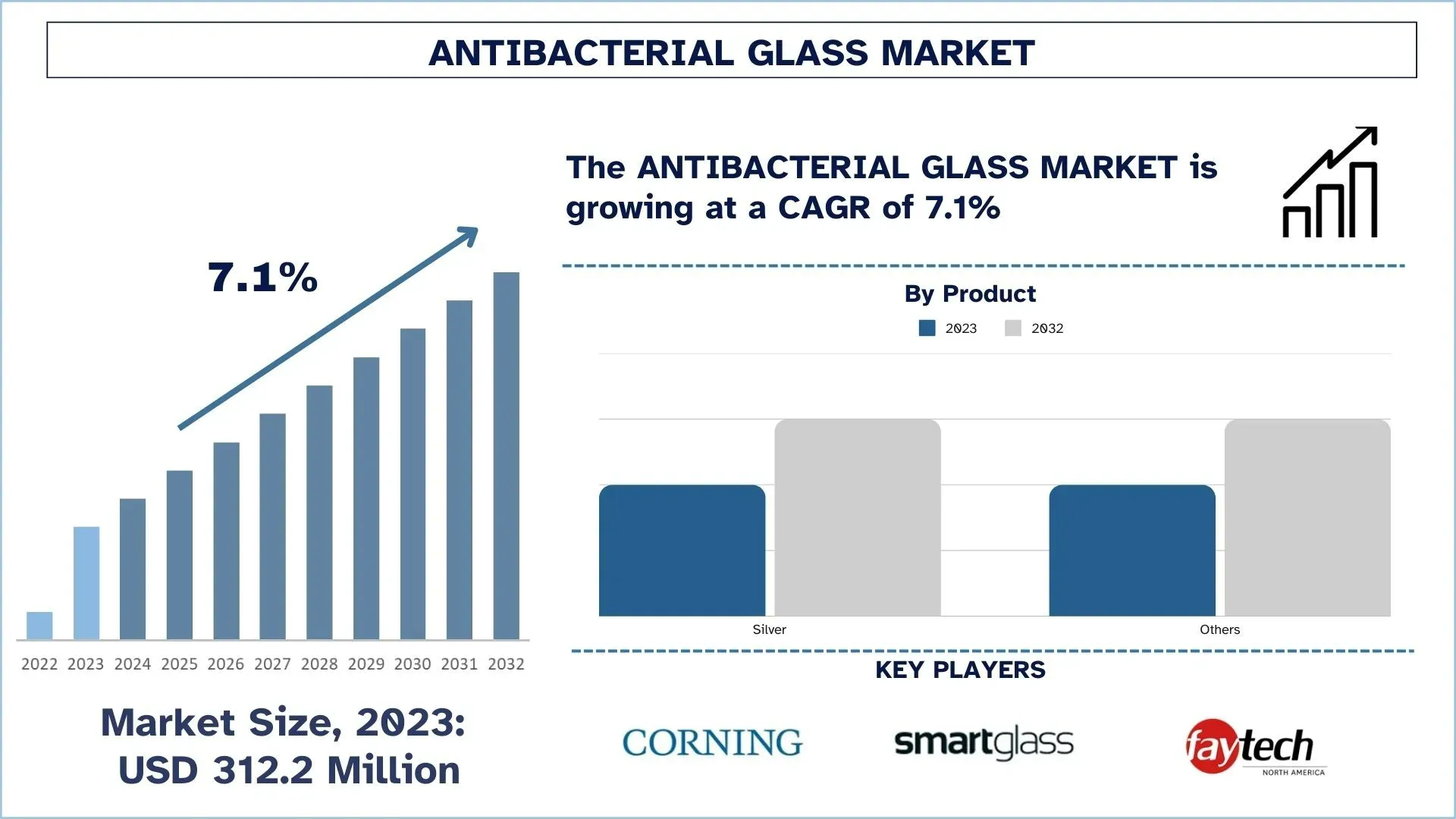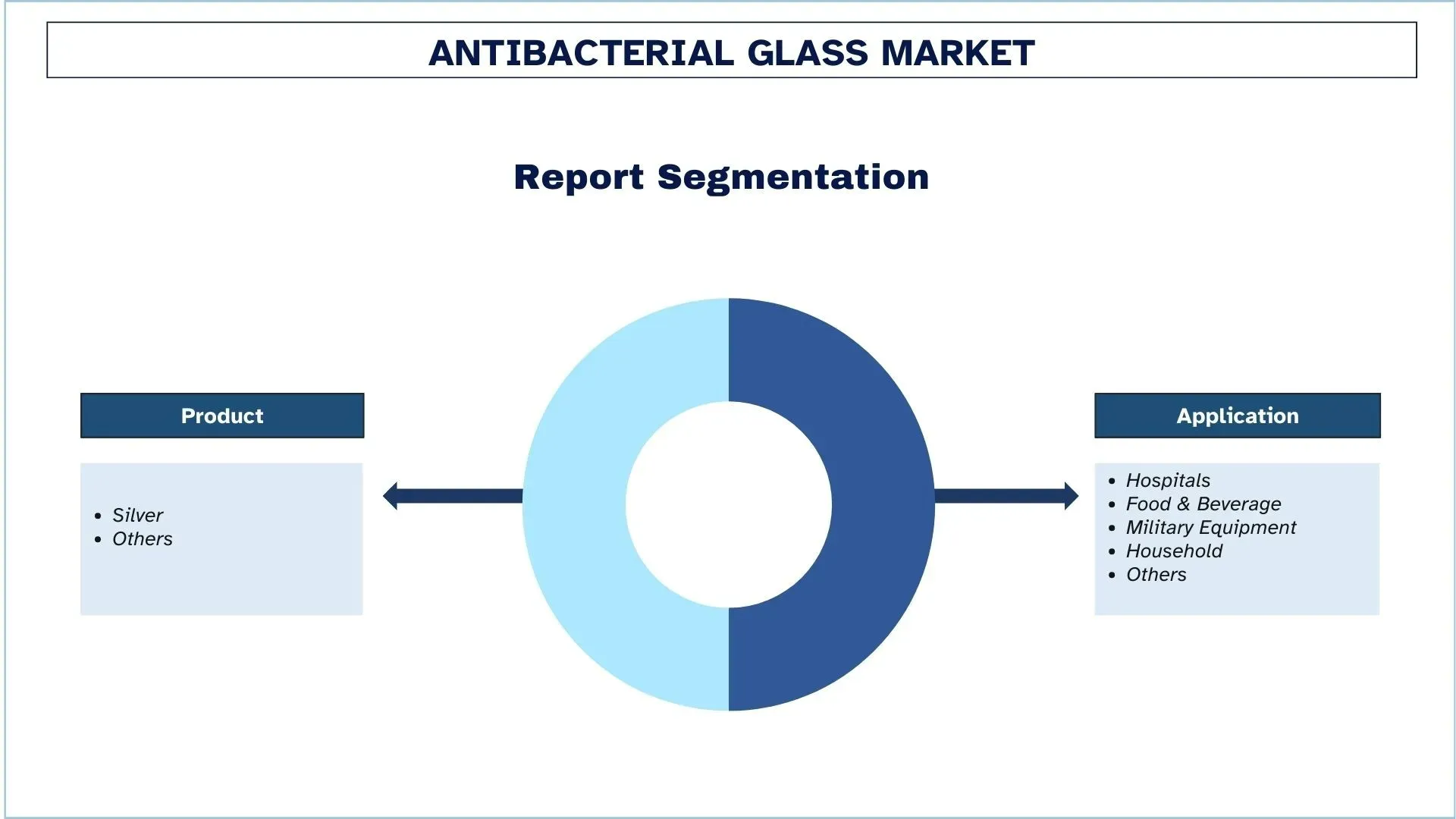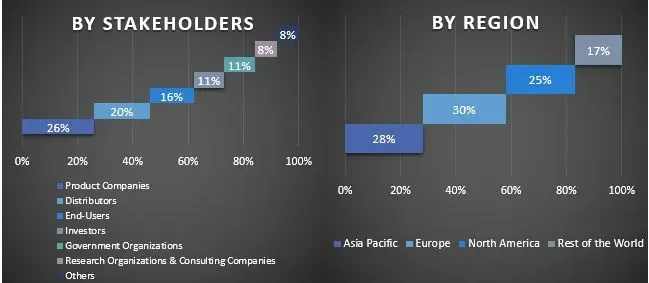- Home
- About Us
- Industry
- Services
- Reading
- Contact Us
Antibacterial Glass Market: Current Analysis and Forecast (2024-2032)
Emphasis on Product (Silver and Others); Application (Hospitals, Food & Beverage, Military Equipment, Household, and Other); Region/Country.

Antibacterial Glass Market Size & Forecast
The Antibacterial Glass Market was valued at USD 312.2 Million in 2023 and is expected to grow at a strong CAGR of around 7.1% during the forecast period (2024-2032) owing to the rising demand for antimicrobial surfaces, stringent hygiene regulations, and increasing adoption in healthcare.
Antibacterial Glass Market Analysis
The antibacterial glass market expands because healthcare facilities and food processing facilities, together with public infrastructure, require antimicrobial surfaces. Antibacterial glass consists of glass material that receives antimicrobial treatments through silver, copper, or other appropriate agents to stop bacteria from multiplying on its surface. Market expansion takes place due to stronger hygiene awareness among people along with enhanced regulatory requirements and rising hospital and commercial facility infection control needs. The emphasis on cleanliness after the pandemic, along with improvements in smart glass technology, works to drive market demand higher. The antimicrobial solution market is expanding because of increased use in electronic devices, automotive components, and residential sectors.
China, along with India and the United States, represents the main regions of antibacterial glass market expansion because both countries develop healthcare networks while implementing food safety laws and educating their populations about antimicrobial technology. China, together with India, experienced quick antimicrobial glass adoption because their governments enhanced healthcare services and expanded funding toward public sanitation work, while the United States obtained market gains through its strong hygiene standards alongside substantial technological research in intelligent antimicrobial solutions. The market will experience widespread industrial adaptation because self-cleaning and multifunctional glass solutions continue to advance, which ensures lasting expansion.
Antibacterial Glass Market Trends
This section discusses the key market trends that are influencing the various segments of the Antibacterial Glass market as identified by our team of research experts.
Rising Demand for Antimicrobial Surfaces
The market for antibacterial glass increased rapidly because people need to keep both germs from spreading and maintain clean environments. Hospital areas plus food and restaurant spaces need surfaces that halt dangerous bacteria growth and shield people from contamination. Antibacterial glass strengthens its position in contact-heavy areas because public interest in infection protection grew after COVID-19 struck both national health priorities and the pandemic threat.
Increasing Prevalence of Hospital-Acquired Infections (HAIs)
Hospital-acquired infections pose substantial safety risks at medical facilities because they force patients to stay longer and raise treatment costs as well as death numbers. Medical facilities and clinics add antibacterial glass protection to patient rooms ICUs and operating areas plus medical items to fight microorganisms. The healthcare field needs new facilities that prioritize hygiene during its fight against expanding medical problems which pushes the sector toward antibacterial glass solutions.
Stringent Government Regulations and Hygiene Standards
Government departments, together with regulatory organizations worldwide, maintain solid safety regulations for public health security purposes. The food processing industry and pharmaceuticals, along with hospitality, need to follow hygiene standards by implementing antibacterial glass surfaces in their facilities. Market expansion occurs because manufacturers and businesses develop antimicrobial technology to meet requirements from ISO FDA along with additional safety certifications.
Advancements in Nanotechnology and Antimicrobial Coatings
Anti-bacterial glass became more effective and hard-wearing with self-cleaning functionality due to recent progress in nanomaterials and silver-based coating technology. These developments help industries use antibacterial glass better because new coating improvements assist in smart glass technology and effective anti-microbial solutions. Modern builders favor antibacterial glass for construction because companies continue to research effective low-cost ways to make it effective.

APAC is Expected to Grow with Significant CAGR During Forecast Period
The APAC antibacterial glass industry is developing rapidly because countries here place more importance on proper sanitation practices in multiple sectors. Chinese, Indian, and Japanese healthcare facilities need more antibacterial glass since they are expanding their medical facilities to prevent patients from getting infections at hospitals. Food and beverage businesses plus consumer goods companies now use antibacterial glass to meet their hygiene standards and promote product safety. The development of smart cities through urban growth creates higher demand for antibacterial glass use at public facilities and transportation centers.
The market expansion occurs because of nanotechnology and antimicrobial coating developments, while government policies that support safety and hygiene standards play a key role. The APAC nations are boosting their funding in antibacterial glass research that leads to affordable production of high-performance materials. Antimicrobial coatings are integrated into touchscreens and smart devices by the electronic industry to expand market applications. The antibacterial glass market in APAC shows potential as a major sector because of its escalating industrial sector along with increased awareness among consumers combined with favorable regulatory policies.

Antibacterial Glass Market Competitive Landscape
The Antibacterial Glass market is competitive and fragmented, with the presence of several global and international market players. The key players are adopting different growth strategies to enhance their market presence, such as partnerships, agreements, collaborations, new product launches, geographical expansions, and mergers and acquisitions.
Top Antibacterial Glass Manufacturing Companies
Some of the major players operating in the market include Corning Inc., Smartglass International, Kastus (Faytech), Morley Glass & Glazing Ltd, Nippon Electric Glass Co., Ltd., AGC Glass Europe, Microban International, AGI Group, Nippon Sheet Glass Co., Ltd., and Sprinz GmbH & Co.
Antibacterial Glass Market News
In December 2024, AGC Inc. is set to undergo significant leadership changes with new appointments to the Board of Directors and Audit & Supervisory Board, pending shareholder approval in March 2025. A key appointment includes Koji Arima from DENSO Corporation as a new Director of the group. These leadership adjustments are part of AGC’s efforts to enhance its governance and leadership capabilities.
Antibacterial Glass Market Report Coverage
Report Attribute | Details |
Base year | 2023 |
Forecast period | 2024-2032 |
Growth momentum | Accelerate at a CAGR of 7.1% |
Market size 2023 | USD 312.2 Million |
Regional analysis | North America, Europe, APAC, Rest of the World |
Major contributing region | Asia-Pacific is expected to grow at the highest CAGR during the forecasted period |
Key countries covered | U.S., Canada, Germany, Spain, Italy, France, United Kingdom, China, Japan, South Korea, and India |
Companies profiled | Corning Inc., Smartglass International, Kastus (Faytech), Morley Glass & Glazing Ltd, Nippon Electric Glass Co., Ltd., AGC Glass Europe, Microban International, AGI Group, Nippon Sheet Glass Co., Ltd., and Sprinz GmbH & Co. |
Report Scope | Market Trends, Drivers, and Restraints; Revenue Estimation and Forecast; Segmentation Analysis; Demand and Supply Side Analysis; Competitive Landscape; Company Profiling |
Segments Covered | By Product; By Application; By Region/Country |
Reasons to buy this report:
The study includes market sizing and forecasting analysis validated by authenticated key industry experts.
The report presents a quick review of overall industry performance at one glance.
The report covers an in-depth analysis of prominent industry peers with a primary focus on key business financials, product portfolios, expansion strategies, and recent developments.
Detailed examination of drivers, restraints, key trends, and opportunities prevailing in the industry.
The study comprehensively covers the market across different segments.
Deep dive regional level analysis of the industry.
Customization Options:
The global Antibacterial Glass market can further be customized as per the requirement or any other market segment. Besides this, UMI understands that you may have your own business needs, hence feel free to contact us to get a report that completely suits your requirements.
Table of Content
Research Methodology for the Antibacterial Glass Market Analysis (2024-2032)
Analyzing the historical market, estimating the current market, and forecasting the future market of global Antibacterial Glass were the three major steps undertaken to create and explore the adoption of Antibacterial Glass in major regions globally. Exhaustive secondary research was conducted to collect the historical market numbers and estimate the current market size. Secondly, numerous findings and assumptions were taken into consideration to validate these insights. Moreover, exhaustive primary interviews were also conducted with industry experts across the value chain of the global Antibacterial Glass market. Post assumption and validation of market numbers through primary interviews, we employed a top-down/bottom-up approach to forecasting the complete market size. Thereafter, market breakdown and data triangulation methods were adopted to estimate and analyze the market size of segments and sub-segments of the industry. Detailed methodology is explained below:
Analysis of Historical Market Size
Step 1: In-Depth Study of Secondary Sources:
Detail secondary study was conducted to obtain the historical market size of Antibacterial Glass through company internal sources such as annual reports & financial statements, performance presentations, press releases, etc., and external sources including journals, news & articles, government publications, competitor publications, sector reports, third-party database, and other credible publications.
Step 2: Market Segmentation:
After obtaining the historical market size of Antibacterial Glass, we conducted a detailed secondary analysis to gather historical market insights and share for different segments and sub-segments for major regions. Major segments are included in the report, such as Product and Application. Further country-level analyses were conducted to evaluate the overall adoption of testing models in that region.
Step 3: Factor Analysis:
After acquiring the historical market size of different segments and sub-segments, we conducted a detailed factor analysis to estimate the current market size of Antibacterial Glass. Further, we conducted factor analysis using dependent and independent variables such as Product and Application of Antibacterial Glass market. A thorough analysis was conducted of demand and supply-side scenarios considering top partnerships, mergers and acquisitions, business expansion, and product launches in the Antibacterial Glass sector across the globe.
Current Market Size Estimate & Forecast
Current Market Sizing: Based on actionable insights from the above 3 steps, we arrived at the current market size, key players in the global Antibacterial Glass market, and market shares of the segments. All the required percentage shares split, and market breakdowns were determined using the above-mentioned secondary approach and were verified through primary interviews.
Estimation & Forecasting: For market estimation and forecast, weights were assigned to different factors including drivers & trends, restraints, and opportunities available for the stakeholders. After analyzing these factors, relevant forecasting techniques i.e., the top-down/bottom-up approach were applied to arrive at the market forecast for 2032 for different segments and sub-segments across the major markets globally. The research methodology adopted to estimate the market size encompasses:
The industry’s market size, in terms of revenue (USD) and the adoption rate of the Antibacterial Glass across the major markets domestically
All percentage shares, splits, and breakdowns of market segments and sub-segments
Key players in the global Antibacterial Glass market in terms of products offered. Also, the growth strategies adopted by these players to compete in the fast-growing market
Market Size and Share Validation
Primary Research: In-depth interviews were conducted with the Key Opinion Leaders (KOLs) including Top Level Executives (CXO/VPs, Sales Head, Marketing Head, Operational Head, Regional Head, Country Head, etc.) across major regions. Primary research findings were then summarized, and statistical analysis was performed to prove the stated hypothesis. Inputs from primary research were consolidated with secondary findings, hence turning information into actionable insights.
Split of Primary Participants in Different Regions

Market Engineering
The data triangulation technique was employed to complete the overall market estimation and to arrive at precise statistical numbers for each segment and sub-segment of the global Antibacterial Glass market. Data was split into several segments & sub-segments post studying various parameters and trends in the areas of Product and Application in the global Antibacterial Glass market.
The main objective of the Global Antibacterial Glass Market Study
The current & future market trends of the global Antibacterial Glass market were pinpointed in the study. Investors can gain strategic insights to base their discretion for investments on the qualitative and quantitative analysis performed in the study. Current and future market trends determined the overall attractiveness of the market at a regional level, providing a platform for the industrial participant to exploit the untapped market to benefit from a first-mover advantage. Other quantitative goals of the studies include:
Analyze the current and forecast market size of Antibacterial Glass industry in terms of value (USD). Also, analyze the current and forecast market size of different segments and sub-segments
Segments in the study include areas of Product and Application
Define and analysis of the regulatory framework for the Antibacterial Glass industry
Analyze the value chain involved with the presence of various intermediaries, along with analyzing customer and competitor behaviors of the industry
Analyze the current and forecast market size of the Antibacterial Glass market for the major region
Major countries of regions studied in the report include Asia Pacific, Europe, North America, and the Rest of the World
Company profiles of the Antibacterial Glass market and the growth strategies adopted by the market players to sustain in the fast-growing market
Deep dive regional level analysis of the industry.
Frequently Asked Questions FAQs
Q1: What is the current market size and growth potential of the Antibacterial Glass market?
The Antibacterial Glass Market was valued at USD 312.2 Million in 2023 and is expected to grow at a strong CAGR of around 7.1% during the forecast period (2024-2032).
Q2: What are the driving factors for the growth of the Antibacterial Glass market?
The growth of the antibacterial glass market is driven by increasing demand for hygienic solutions, rising concerns over infection control, and stringent regulatory standards across industries like healthcare, food & beverage, and public infrastructure.
Q3: Which segment has the largest share in the Antibacterial Glass market by Application?
The Hospitals segment has the largest share of the Antibacterial Glass market by Application.
Q4: What are the emerging technologies and trends in the Antibacterial Glass market?
Emerging technologies and trends in the antibacterial glass market include nanotechnology-based coatings, self-cleaning glass solutions, and advanced silver-ion antimicrobial treatments for enhanced performance and durability.
Q5: Which region will dominate in the Antibacterial Glass market?
APAC is expected to dominate the market during the forecast period.
Related Reports
Customers who bought this item also bought










